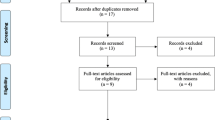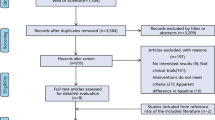Abstract
Introduction
Stem cell therapies have been proposed in preclinical trials as new treatment options in abdominal wall repair.
Materials and Methods
This work lists sources of feasible cell lines and the current status of literature and provides a cautious outlook into future developments. Special attention was paid to translational issues and practicabilty in a complex field.
Conclusion
Cell-based therapies will play a role in the clinical setting in the future. Regulatory and ethical issues need to be addressed as well as the proof of cost-effectiveness.
Similar content being viewed by others
References
Adas G, Kemik O, Eryasar B et al (2013) Treatment of ischemic colonic anastomoses with systemic transplanted bone marrow derived mesenchymal stem cells. Eur Rev Med Pharmacol Sci 17:2275–2285
Altman AM, Abdul Khalek FJ, Alt EU, Butler CE (2010) Adipose tissue-derived stem cells enhance bioprosthetic mesh repair of ventral hernias. Plast Reconstr Surg 126:845–854. doi:10.1097/PRS.0b013e3181e6044f
Astori G, Vignati F, Bardelli S et al (2007) “In vitro” and multicolor phenotypic characterization of cell subpopulations identified in fresh human adipose tissue stromal vascular fraction and in the derived mesenchymal stem cells. J Transl Med 5:55. doi:10.1186/1479-5876-5-55
Bryan N, Ahswin H, Smart N et al (2013) The in vivo evaluation of tissue-based biomaterials in a rat full-thickness abdominal wall defect model. J Biomed Mater Res Part B Appl Biomater. doi:10.1002/jbm.b.33050
Chatterjee A, Krishnan NM, Rosen JM (2013) Complex ventral hernia repair using components separation with or without biologic mesh: a cost-utility analysis. Ann Plast Surg. doi:10.1097/SAP.0b013e31829fd306
Davis RP, Nemes C, Varga E et al (2013) Generation of induced pluripotent stem cells from human foetal fibroblasts using the Sleeping Beauty transposon gene delivery system. Differentiation 86:30–37. doi:10.1016/j.diff.2013.06.002
De Coppi P, Bellini S, Conconi MT (2006) Myoblast-acellular skeletal muscle matrix constructs guarantee a long-term repair of experimental full-thickness abdominal wall defects. Tissue Eng Jul 12(7):1929–1936
Dolce CJ, Stefanidis D, Keller JE et al (2010) Pushing the envelope in biomaterial research: initial results of prosthetic coating with stem cells in a rat model. Surg Endosc 24:2687–2693. doi:10.1007/s00464-010-1026-x
Ethics Committee of American Society for Reproductive Medicine (2013) Donating embryos for human embryonic stem cell (hESC) research: a committee opinion. Fertil Steril 100:935–939. doi:10.1016/j.fertnstert.2013.08.038
Fairchild P (2013) Interview: immunogenicity: the elephant in the room for regenerative medicine? Interviewed by Alexandra Hemsley. Regen Med 8:23–26. doi:10.2217/rme.12.110
Fatimah SS, Chua K, Tan GC et al (2013) Organotypic culture of human amnion cells in air-liquid interface as a potential substitute for skin regeneration. Cytotherapy 15:1030–1041. doi:10.1016/j.jcyt.2013.05.003
Fortelny RH, Hofmann A, Gruber-Blum S et al (2013) Delayed closure of open abdomen in septic patients is facilitated by combined negative pressure wound therapy and dynamic fascial suture. Surg Endosc. doi:10.1007/s00464-013-3251-6
Fraser JK, Zhu M, Wulur I, Alfonso Z (2008) Adipose-derived stem cells. Methods Mol Biol 449:59–67. doi:10.1007/978-1-60327-169-1_4
Gerullis H, Georgas E, Eimer C et al (2013) Coating with autologous plasma improves biocompatibility of mesh grafts in vitro: development stage of a surgical innovation. Biomed Res Int 2013:536814. doi:10.1155/2013/536814
Gimble JM, Bunnell BA, Guilak F (2012) Human adipose-derived cells: an update on the transition to clinical translation. Regen Med 7:225–235. doi:10.2217/rme.11.119
Grumezescu AM, Holban AM, Andronescu E et al (2013) Anionic polymers and 10 nm Fe3O4@UA wound dressings support human foetal stem cells normal development and exhibit great antimicrobial properties. Int J Pharm. doi:10.1016/j.ijpharm.2013.08.026
Herberts CA, Kwa MSG, Hermsen HPH (2011) Risk factors in the development of stem cell therapy. J Transl Med 9:29. doi:10.1186/1479-5876-9-29
Holnthoner W, Hohenegger K, Husa A-M (2012) Adipose-derived stem cells induce vascular tube formation of outgrowth endothelial cells in a fibrin matrix. J Tissue Eng Regen Med. doi:10.1002/term.1620
Katz AJ, Llull R, Hedrick MH, Futrell JW (1999) Emerging approaches to the tissue engineering of fat. Clin Plast Surg 26:587–603
Keeney M, Deveza L, Yang F (2013) Programming stem cells for therapeutic angiogenesis using biodegradable polymeric nanoparticles. J Vis Exp e50736. doi:10.3791/50736
Killeen S, Devaney A, Mannion M et al (2013) Omental pedicle flaps following proctectomy: a systematic review. Colorectal Dis 15:e634–e645. doi:10.1111/codi.12394
Killeen S, Mannion M, Devaney A, Winter DC (2013) Omentoplasty to assist perineal defect closure following laparoscopic abdominoperineal resection. Colorectal Dis 15:e623–e626. doi:10.1111/codi.12426
Klinge U, Junge K, Mertens PR (2004) Herniosis: a biological approach. Hernia Dec 8(4):300–301
Lai JY, Chang PY, Lin JN (2003) Body wall repair using small intestinal submucosa seeded with cells. J Pediatr Surg 38(12):1752–1755 PubMed PMID: 14666459
Lee VK, Singh G, Trasatti JP et al (2013) Design and fabrication of human skin by 3d bioprinting. Tissue Eng Part C Methods. doi:10.1089/ten.TEC.2013.0335
Lee WYW, Zhang T, Lau CPY et al (2013) Immortalized human fetal bone marrow-derived mesenchymal stromal cell expressing suicide gene for anti-tumor therapy in vitro and in vivo. Cytotherapy 15:1484–1497. doi:10.1016/j.jcyt.2013.06.010
Li L-Q, Gao J-H, Lu F et al (2012) Experimental study of the effect of adipose stromal vascular fraction cells with VEGF on the neovascularization of free fat transplantation. Zhonghua Zheng Xing Wai Ke Za Zhi 28:122–126
Liu B, Tan X-Y, Liu Y-P et al (2013) The adjuvant use of stromal vascular fraction and platelet-rich fibrin for autologous adipose tissue transplantation. Tissue Eng Part C Methods 19:1–14. doi:10.1089/ten.TEC.2012.0126
Logan MS, Propst JT, Nottingham JM et al (2010) Human satellite progenitor cells for use in myofascial repair: isolation and characterization. Ann Plast Surg 64(6):794–799. doi:10.1097/SAP.0b013e3181b025cb
McFarlin K, Gao X, Liu YB, Dulchavsky DS et al (2006) Bone marrow-derived mesenchymal stromal cells accelerate wound healing in the rat. Wound Repair Regen 14(4):471–478
Mertes H (2013) A moratorium on breeding better babies. J Med Ethics. doi:10.1136/medethics-2013-101560
Niemansburg SL, Teraa M, Hesam H et al (2013) Stem cell trials for cardiovascular medicine: ethical rationale. Tissue Eng Part A. doi:10.1089/ten.TEA.2013.0332
Niknejad H, Paeini-Vayghan G, Tehrani FA et al (2013) Side dependent effects of the human amnion on angiogenesis. Placenta 34:340–345. doi:10.1016/j.placenta.2013.02.001
Nirmal RS, Nair PD (2013) Significance of soluble growth factors in the chondrogenic response of human umbilical cord matrix stem cells in a porous three dimensional scaffold. Eur Cell Mater 26:234–251
Perota A, Lagutina I, Duchi R et al (2013) 215 live piglets generated by somatic cell nuclear transfer following targeting of a porcine enhanced green fluorescent protein line mediated by zinc-finger nucleases to establish cloned hygromycin-resistant primary cell lines suitable for cre-mediated recombinase-mediated cassette exchange. Reprod Fertil Dev 26:221–222. doi:10.1071/RDv26n1Ab215
Petter-Puchner AH, Dietz UA (2013) Biological implants in abdominal wall repair. Br J Surg 100:987–988. doi:10.1002/bjs.9156
Petter-Puchner AH, Fortelny RH, Mika K et al (2010) Human vital amniotic membrane reduces adhesions in experimental intraperitoneal onlay mesh repair. Surg Endosc 25:2125–2131. doi:10.1007/s00464-010-1507-y
Rada T, Reis RL, Gomes ME (2009) Adipose tissue-derived stem cells and their application in bone and cartilage tissue engineering. Tissue Eng Part B Rev 15:113–125. doi:10.1089/ten.teb.2008.0423
Rehman J, Traktuev D, Li J et al (2004) Secretion of angiogenic and antiapoptotic factors by human adipose stromal cells. Circulation 109:1292–1298. doi:10.1161/01.CIR.0000121425.42966.F1
Sheng L, Yang M, Li H et al (2011) Transplantation of adipose stromal cells promotes neovascularization of random skin flaps. Tohoku J Exp Med 224:229–234
Song Z, Peng Z, Liu Z, Yang J, Tang R, Gu Y (2013) Reconstruction of abdominal wall musculofascial defects with small intestinal submucosa scaffolds seeded with tenocytes in rats. Tissue Eng Part A 19(13–14):1543–1553
Stroud T, Xiang T, Romo S, Kjelland ME (2013) 38 rocky mountain bighorn sheep (ovis canadensis canadensis) embryos produced using somatic cell nuclear transfer. Reprod Fertil Dev 26:133. doi:10.1071/RDv26n1Ab38
Sykova E, Forostyak S (2013) Stem cells in regenerative medicine. Laser Ther 22:87–92. doi:10.3136/islsm.22.87
Von Heimburg D, Hemmrich K, Zachariah S et al (2005) Oxygen consumption in undifferentiated versus differentiated adipogenic mesenchymal precursor cells. Respir Physiol Neurobiol 146:107–116. doi:10.1016/j.resp.2004.12.013
Wolf MT, Carruthers CA, Dearth CL et al (2013) Polypropylene surgical mesh coated with extracellular matrix mitigates the host foreign body response. J Biomed Mater Res A. doi:10.1002/jbm.a.34671
Zhang WY, de Almeida PE (2008) A tool for monitoring pluripotency in stem cell research. StemBook. Teratoma Formation, Cambridge
Zhao Y, Zhang Z, Wang J et al (2012) Abdominal hernia repair with a decellularized dermal scaffold seeded with autologous bone marrow-derived mesenchymal stem cells. Artif Organs 36:247–255. doi:10.1111/j.1525-1594.2011.01343.x
Zuk PA, Zhu M, Mizuno H et al (2001) Multilineage cells from human adipose tissue: implications for cell-based therapies. Tissue Eng 7:211–228. doi:10.1089/107632701300062859
Zuk PA, Zhu M, Ashjian P et al (2002) Human adipose tissue is a source of multipotent stem cells. Mol Biol Cell 13:4279–4295. doi:10.1091/mbc.E02-02-0105
Acknowledgments
The authors report that they have no disclosures or financial interests in conducting and publishing this review.
Author information
Authors and Affiliations
Corresponding author
Rights and permissions
About this article
Cite this article
Petter-Puchner, A.H., Fortelny, R.H., Gruber-Blum, S. et al. The future of stem cell therapy in hernia and abdominal wall repair. Hernia 19, 25–31 (2015). https://doi.org/10.1007/s10029-014-1288-7
Received:
Accepted:
Published:
Issue Date:
DOI: https://doi.org/10.1007/s10029-014-1288-7




